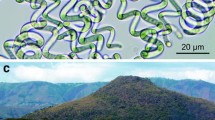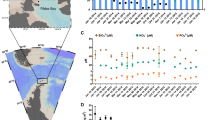Abstract
The aim of this study was to compare a molecular and a microscopic approach to study the planktonic eukaryotic diversity of an oligotrophic lake. Plankton samples from the temperate Lake Stechlin were assessed in winter and summer 2008 by comparison of 18S rRNA gene clone libraries to light microscopic evaluations. For both approaches identical samples were used. There were remarkable differences between the main groups recovered by the contrasting methods. The microscopic analyses showed predominance of autotrophic planktonic organisms, whereas most of them could not be discovered by the molecular method which resulted in a higher diversity of heterotrophic flagellates. The microscopic survey revealed high diversity of Chlorophyta and Cryptophyta as well as the Stramenopiles groups of Bacillariophyceae and Chrysophyceae. The clone libraries, based on full-length 18S rRNA gene sequences, displayed highest diversity of Alveolata belonging to seven different subclades. Notably, Antarctic Dinophyta-related clones were detected. The occurrence of the marine phagotrophic flagellate Telonema was also documented. Comparing the two sampling seasons, rich diversity suggests that flagellates played an important role in late winter (February), however, there is relatively low diversity in summer (August). The newly discovered molecular diversity of planktonic eukaryotes in Stechlin will help to understand the biodiversity patterns in freshwater lakes.




Similar content being viewed by others
References
Adl, S. M., A. G. B. Simpson, M. A. Farmer, R. A. Andersen, O. R. Anderson & J. R. Barta, 2005. The new higher level classification of eukaryotes with emphasis on the taxonomy of protists. Journal of Eukaryotic Microbiology 52: 399–451.
Bock, C., T. Pröschold & L. Krienitz, 2010. Two new Dictyosphaerium-morphotype lineages of the Chlorellaceae (Trebouxiophyceae): Heynigia gen nov. and Hindakia gen. nov. European Journal of Phycology 45: 267–277.
Casper, S. J., 1985a. Lake Stechlin. A Temperate Oligotrophic Lake. Dr. W. Junk Publ., Dordrecht, Boston, Lancaster: 553 pp.
Casper, S. J., 1985b. The phytoplankton. In Casper, S. J. (ed.), Lake Stechlin. A Temperate Oligotrophic Lake. Dr. W. Junk Publ., Dordrecht, Boston, Lancaster: 157–195.
Cavalier-Smith, T. & E. E. Chao, 2003. Phylogeny of choanozoa, apusozoa, and other protozoa and early eukaryote megaevolution. Journal of Molecular Evolution 56: 540–563.
Chao, A., 1987. Estimating the population size for capture-recapture data with unequal catchability. Biometrics 43: 783–791.
Díez, B., C. Pedrós-Alió & R. Masanna, 2001. Study of genetic diversity of eukaryotic picoplankton in different oceanic regions by small-subunit rRNA gene cloning and sequencing. Applied and Environmental Microbiology 67: 2932–2941.
Ettl, H., 1983. Chlorophyta I, Phytomonadina. In Ettl, H., J. Gerloff, H. Heynig & D. Mollenhauer (eds), Süßwasserflora von Mitteleuropa. Fischer Verlag, Jena: 807 pp.
Gast, R. J., D. M. Moran, D. J. Beaudoin, J. N. Blythe, M. R. Dennett & D. A. Caron, 2006. Abundance of a novel dinoflagellate phylotype in the Ross Sea, Antarctica. Journal of Phycology 42: 233–242.
Gervais, F., J. Padisák & R. Koschel, 1997. Do light quality and low phosphorus concentration favour picocyanobacteria below the thermocline of the oligotrophic Lake Stechlin? Journal of Plankton Research 19: 771–781.
Hansen, L. R., J. Kristiansen & J. V. Rasmussen, 1994. Potential toxicity of the freshwater Chrysochromulina species C. parva (Prymnesiophyceae). Hydrobiologia 287: 157–159.
Hegewald, E., J. Padisák & T. Friedl, 2007. Pseudotetraedriella kamillae: taxonomy and ecology of a new member of the algal class Eustigmatophyceae (Stramenopiles). Hydrobiologia 586: 107–116.
Hepperle, D. & L. Krienitz, 2001. Systematics and ecology of chlorophyte picoplankton in German inland waters along a nutrient gradient. International Review of Hydrobiology 86: 269–284.
Hoef-Emden, K., 2007. Revision of the genus Cryptomonas (Cryptophyceae) II: incongruences between the classical morphospecies concept and molecular phylogeny in smaller pyrenoid-less cells. Phycologia 46: 402–428.
Hoef-Emden, K. & M. Melkonian, 2003. Revision of the genus Cryptomonas (Cryptophyceae): a combination of molecular phylogeny and morphology provides insights into a long-hidden dimorphism. Protist 154: 371–409.
Hughes, J. B., J. J. Hellmann, T. H. Ricketts & B. J. M. Bohannan, 2001. Counting the uncountable: statistical approaches to estimating microbial diversity. Applied and Environmental Microbiology 67: 4399–4406.
Huss, V. A. R., C. Frank, E. C. Hartmann, M. Hirmer, A. Kloboucek, B. M. Seidel, P. Wenzeler & E. Kessler, 1999. Biochemical taxonomy and molecular phylogeny of the genus Chlorella sensu lato (Chlorophyta). Journal of Phycology 35: 587–598.
Kaczmarska, I., M. Beaton, A. C. Benoit & L. K. Medlin, 2005. Molecular phylogeny of selected members of the order Thalassiosirales (Bacillariophyta) and evolution of the fultoportula. Journal of Phycology 42: 121–138.
Kagami, M., A. de Bruin, B. W. Ibelings & E. Van Donk, 2007. Parasitic chytrids: their effects on phytoplankton communities and food-web dynamics. Hydrobiologia 578: 113–129.
Klaveness, D., K. Shalchian-Tabrizi, H. A. Thomsen, W. Eikrem & K. S. Jakobsen, 2005. Telonema antarcticum sp nov., a common marine phagotrophic flagellate. International Journal of Systematic and Evolutionary Microbiology 55: 2595–2604.
Koschel, R., 1976. Der Einfluss des Phosphorangebotes auf die Primärproduktion des Phytoplanktons in einem geschichteten Klarwassersee (Stechlinsee, DDR). Limnologica 10: 325–346.
Krienitz, L. & W. Scheffler, 1994. The Selenastraceae of the oligotrophic Lake Stechlin (Brandenburg, Germany). Biologia 49: 463–471.
Krienitz, L., H. Takeda & D. Hepperle, 1999. Ultrastructure, cell wall composition, and phylogenetic position of Pseudodictyosphaerium jurisii (Chlorococcales, Chlorophyta) including a comparison with other picoplanktonic green algae. Phycologia 38: 100–1007.
Krienitz, L., E. H. Hegewald, D. Hepperle, V. A. R. Huss, T. Rohr & M. Wolf, 2004. Phylogenetic relationship of Chlorella and Parachlorella gen nov. (Chlorophyta, Trebouxiophyceae). Phycologia 43: 529–542.
Krienitz, L., C. Bock, P. K. Dadheech & T. Pröschold, 2010a. Taxonomic reassessment of the genus Mychonastes (Chlorophyceae, Chlorophyta) including the description of eight new species. Phycologia 49 (in press).
Krienitz, L., C. Bock, W. Luo & T. Pröschold, 2010b. Polyphyletic origin of the Dictyosphaerium-morphotype within Chlorellaceae (Trebouxiophyceae). Journal of Phycology 46: 559–563.
Küchler, L., 1981. Phytoplanktonuntersuchungen im Stechlinseegebiet in den Jahren 1973–1975. Limnologica 13: 83–99.
Küchler, L., 1982. Phytoplanktonuntersuchungen im Stechlin und im Nordbecken des Nehmitzsees. Limnologica 14: 231–241.
Lefèvre, E., C. Bardot, C. Noēl, J. F. Carrias, E. Viscogliosi, C. Amblard & T. Sime-Ngando, 2007. Unveiling fungal zooflagellates as members of freshwater picoeukaryotes: evidence from a molecular diversity study in a deep meromictic lake. Environmental Microbiology 9: 61–71.
Lefèvre, E., B. Roussel, C. Amblard & T. Sime-Ngando, 2008. The molecular diversity of freshwater picoeukaryotes reveals high occurrence of putative parasitoids in the plankton. Plos One 3: e2324.
Lefranc, M., A. Thenot, C. Lepere & D. Debroas, 2005. Genetic diversity of small eukaryotes in lakes differing by their trophic status. Applied Environmental Microbiology 71: 5935–5942.
Lund, J. W. G., C. Kipling & E. D. LeCren, 1958. The inverted microscope method of estimating algal numbers and the statistical basis of estimations by counting. Hydrobiologia 11: 143–170.
Luo, W., S. Pflugmacher, T. Pröschold, N. Walz & L. Krienitz, 2006. Genotype versus phenotype variability in Chlorella and Micractinium (Chlorophyta, Trebouxiophyceae). Protist 157: 315–333.
Luo, W., H. R. Li, M. H. Cai & J. F. He, 2009. Diversity of microbial eukaryotes in Kongsfjorden, Svalbard. Hydrobiologia 636: 233–248.
Massana, R., V. Balagué, L. Guillou & C. Pedrós-Alió, 2004. Picoeukaryotic diversity in an oligotrophic coastal site studied by molecular and culturing approaches. FEMS Microbiology Ecology 50: 231–243.
Medlin, L. K., H. J. Elwood, S. Stickel & M. L. Sogin, 1988. The characterization of enzymatically amplified eukaryotic 16S-like rRNA-coding regions. Gene 71: 491–499.
Medlin, L. K., A. G. Saez & J. R. Young, 2008. A molecular clock for coccolithophores and implications for selectivity of phytoplankton extinctions across the K/T boundary. Marine Micropaleontology 67: 69–86.
Mehner, T., J. Padisák, P. Kasprzak, R. Koschel & L. Krienitz, 2008. A test of food web hypotheses by exploring time series of fish, zooplankton and phytoplankton in an oligo-mesotrophic lake. Limnologica 38: 179–188.
Moon-van der Staay, S. Y., R. De Wachter & D. Vaulot, 2001. Oceanic 18S rDNA sequences from picoplankton reveal unsuspected eukaryotic diversity. Nature 409: 607–610.
Not, F., R. Gausling, F. Azam, J. F. Heidelberg & A. Z. Worden, 2007. Vertical distribution of picoeukaryotic diversity in the Sargasso Sea. Environmental Microbiology 9: 1233–1252.
Padisák, J., L. Krienitz, R. Koschel & J. Nedoma, 1997. Deep-layer autotrophic picoplankton maximum in the oligotrophic Lake Stechlin, Germany: origin, activity, development and erosion. European Journal of Phycology 32: 403–416.
Padisák, J., L. Krienitz, W. Scheffler, R. Koschel, J. Kristiansen & I. Grigorszki, 1998. Phytoplankton succession in the oligotrophic Lake Stechlin (Germany). Hydrobiologia 369/370: 179–197.
Padisák, J., W. Scheffler, P. Kasprzak, R. Koschel & L. Krienitz, 2003. Interannual variability in the phytoplankton composition of Lake Stechlin (1994–2000). Archiv für Hydrobiologie, Special Issue Advances in Limnology 58: 101–133.
Padisák, J., É. Hajnal, L. Naselli Flores, M. T. Dokulil, P. Nõges & T. Zohary, 2010a. Convergence and divergence in organization of phytoplankton communities under various regimes of physical and biological control. Hydrobiologia 639: 205–220.
Padisák, J., É. Hajnal, L. Krienitz, J. Lakner & V. Üveges, 2010b. Rarity, ecological memory, rate of floral change in phytoplankton–and the mystery of the Red Cock. Hydrobiologia 653: 45–64.
Potter, D., T. C. Lajeunesse, G. W. Saunders & R. A. Anderson, 1997. Convergent evolution masks extensive biodiversity among marine coccoid picoplankton. Biodiversity and Conservation 6: 99–107.
Pröschold, T., T. Darienko, P.C. Silva, W. Reisser & L. Krienitz, 2010. The systematics of Zoochlorella revisited employing an integrative approach. Environmental Microbiology. doi:10.1111/j.1462-2920.2010.02333.x.
Richards, T. A., A. A. Vepritskiy, D. E. Gouliamova & S. A. Nierzwicki-Bauer, 2005. The molecular diversity of freshwater picoeukaryotes from an oligotrophic lake reveals diverse, distinctive and globally dispersed lineages. Environmental Microbiology 7: 1413–1425.
Scheffler, W. & J. Padisák, 1997. Cyclotella tripartita Håkansson (Bacillariophyceae), a dominant diatom species in the oligotrophic Stechlinsee (Germany). Nova Hedwigia 65: 221–232.
Scheffler, W. & J. Padisák, 2000. Stephanocostis chantaicus (Bacillariophyceae): morphology and population dynamics of a rare centric diatom growing in winter under ice in the oligotrophic Lake Stechlin, Germany. Archiv für Hydrobiologie 98, Algological Studies 133: 49–69.
Scheffler, W., A. Nicklisch & D. Hepperle, 2003. Dimorphism in Cyclotella pseudocomensis (Heterokontophyta, Bacillariophyceae) as revealed by morphological, ecological and molecular methods. Archiv für Hydrobiologie, Special Issue Advances in Limnology 58: 157–173.
Scheffler, W., A. Nicklisch & I. Schönfelder, 2005. Beiträge zur Morphologie, Ökologie und Ontogenie der planktischen Diatomee Cyclotella comensis Grunow Untersuchungen an historischem und rezenten Material. Diatom Research 20: 171–200.
Schulz, M., R. Koschel, C. Reese & T. Mehner, 2004. Pelagic trophic transfer efficiency in an oligotrophic, dimictic deep lake (Lake Stechlin, Germany) and its relation to fisheries yield. Limnologica 34: 264–273.
Shalchian-Tabrizi, K., K. Eikrem, K. Klaveness, D. Vaulot, M. A. Minge, F. Le Gall, K. Romari, J. Throndsen, A. Botnen, R. Massana, H. A. Thomsen & K. S. Jakobsen, 2006. Telonemia, a new protist phylum with affinity to chromist lineages. Proceedings of Biological Sciences 273: 1833–1842.
Tavera, R. & B. Díez, 2009. Multifaceted approach for the analysis of the phototrophic microbial community in a freshwater recreational area of Xochimilco, México. Hydrobiologia 636: 353–368.
Vaulot, D., W. Eikrem, M. Viprey & H. Moreau, 2008. The diversity of small eukaryotic phytoplankton (≤3 μm) in marine ecosystems. FEMS Microbiology Review 32: 795–820.
Acknowledgments
This research is supported by National Natural Science Foundation of China (No. 40806073). We also thank Y.Y. Lou and L.M. Huang for technical assistance.
Author information
Authors and Affiliations
Corresponding author
Additional information
Handling editor: Luigi Naselli-Flores
Electronic supplementary material
Below is the link to the electronic supplementary material.
Rights and permissions
About this article
Cite this article
Luo, W., Bock, C., Li, H.R. et al. Molecular and microscopic diversity of planktonic eukaryotes in the oligotrophic Lake Stechlin (Germany). Hydrobiologia 661, 133–143 (2011). https://doi.org/10.1007/s10750-010-0510-6
Received:
Revised:
Accepted:
Published:
Issue Date:
DOI: https://doi.org/10.1007/s10750-010-0510-6




